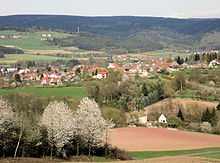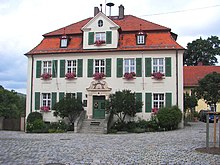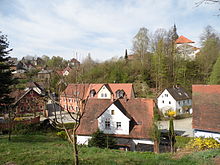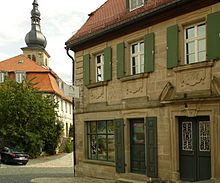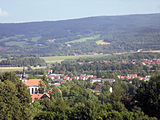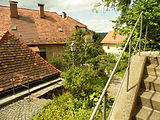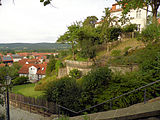Willow Hill
| coat of arms | Germany map | |
|---|---|---|

|
Coordinates: 49 ° 56 ' N , 11 ° 43' E |
|
| Basic data | ||
| State : | Bavaria | |
| Administrative region : | Upper Franconia | |
| County : | Bayreuth | |
| Management Community : | Willow Hill | |
| Height : | 436 m above sea level NHN | |
| Area : | 68.92 km 2 | |
| Residents: | 5799 (Dec. 31, 2019) | |
| Population density : | 84 inhabitants per km 2 | |
| Postal code : | 95466 | |
| Primaries : | 09278, 09209, 0921 | |
| License plate : | BT, EBS , ESB , KEM , MÜB , PEG | |
| Community key : | 09 4 72 199 | |
| Market structure: | 53 parts of the community | |
Market administration address : |
Rathausplatz 1 95466 Weidenberg |
|
| Website : | ||
| Mayor : | Hans Wittauer ( Free Association of Voters ) | |
| Location of the Weidenberg market in the Bayreuth district | ||
Weidenberg is a market in the Upper Franconian district of Bayreuth and the seat of the administrative community Weidenberg , to which the communities Emtmannsberg , Kirchenpingarten and Seybothenreuth also belong.
geography
Geographical location
The municipality of Weidenberg is located between about 357 and 853 m above sea level at the foot of the Fichtelgebirge . The main town and market Weidenberg is located in the north-eastern district of Bayreuth in the valley of the Warm Steinach . The next larger town is Bayreuth , it can be reached via State Road 2181 in the Steinach Valley or via Lankendorfer Berg and Seulbitz as well as by train.
Weidenberg consists of the Obermarkt district on the slope and the Untermarkt district in the valley floor. They are connected to one another by the Neue Straße, which runs in an arch largely outside the development, the bridle path, which is not passable throughout, and a pedestrian staircase called "Schied" with 126 steps.
nature and environment
The Weidenberg market is located on the southern edge of the Fichtelgebirge at the foot of the Iskaraberges in the valley of the Warmen Steinach, whose headwaters are located on the southern slope of the Ochsenkopf . After Sophienthal, a district of Weidenberg, the Steinach leaves its deep valley in the mountains and enters a bright, wide basin around Weidenberg. This basin is a geologically significant part of a fracture zone called the Franconian Line : about 200 million years ago the earth's crust broke and the old mountains ( Variszikum ) pushed over the younger layers of the earth. Primary rocks such as granite , gneiss , phyllite and rotliegend as well as younger rock formations such as red sandstone , shell limestone and keuper can be found in a very small space. With the erosion of the Fichtelgebirge and the removal of the rocks by the Steinach and other rivers, gravel plains were created in the valley area. All these different soil structures led to a small-structured, varied landscape, each with its own fauna and flora .
- Königsheide , a partially swampy high moor
- Keilsteinfelsen near Gossenreuth (Meta-Rhyolite) (Geotope number 472R016)
- Rotenfels iron mine (geotope number 377G009)
- Weidenberger Felsenkeller (geotope number 472A021)
- Carnelian horizons in the red sandstone
- Shell limestone outcrop on the Kulmberg (geotope number 472A007)
Weidenberger Erdblicke
Under the title “Weidenberger Erdblicke”, two geo-adventure trails lead through Weidenberg and the nearby southern foothills of the Fichtelgebirge. Here on the Franconian Line , not only geological epochs, such as the Middle Ages and ancient times, shape the landscape, but also two different river systems that belong to the European main watershed . The two circular routes show almost 500 million years of geological history on 15 and 7 information boards, respectively. The boards are provided with a QR code .
Community structure
The political municipality Weidenberg has 53 officially named parts of the municipality (the type of place is given in brackets ):
|
|
|
|
There are the districts Döhlau, Fischbach, Görschnitz, Lankendorf, Lehen, Lessau, Mengersreuth, Neunkirchen a.Main, Sophienthal, Untersteinach, Weidenberg and Sophienthaler Forst.
Neighboring communities
Neighboring communities are (starting from the north clockwise): Warmensteinach , Kirchenpingarten , Seybothenreuth , Emtmannsberg , Bayreuth and Goldkronach .
history
Until the church is planted
Around the year 1000 the Weidenberg area was populated jointly by the Main Slavs and Franks . Due to the old north-west-south-east oriented trade and military route, it was primarily a transit area. A series of tower mounds was built to secure the roads and the border between Franconian and Bavarian territory. The most important tower hill complex was located above the district of Sophienthal on a strategically favorable mountain spur. This Burgstall castle hill with its clearly visible moats and ramparts can be visited.
Weidenberg was first mentioned in 1223 as the seat of a "Domus", at that time owned by the Lords of Weidenberg . In 1398 the place was attested as a market. In 1418 the noble family of Weidenberg died out, in 1446 Adrian von Künsberg bought the entire property. The lords of Künsberg owned the two castles in Weidenberg as a Zollersches fief until 1634/51. A "lower castle" was first mentioned in 1601, in 1651 it burned down and passed to the Lords of Lindenfels. In 1745 Carl Willibald von Lindenfels sold his estates and fiefdoms in and around Weidenberg to Margrave Friedrich zu Brandenburg-Bayreuth for 84,000 guilders .
In 1750 almost the entire district of Untermarkt fell victim to a fire, on October 2nd, 1770 large parts of the Obermarkt with its wooden houses were destroyed by flames. According to a margravial decree, the houses on the Obermarkt were rebuilt from stone. The reconstruction was led by the margraves' building authority in Bayreuth, closed streets and simple town houses made of sandstone blocks with window aprons and line ornaments. The fine, uniformly grained sandstone was extracted in several quarries in nearby Lessau.
The "Upper Castle" became an office building in 1770 and also served as a prison . The office of the Prussian Principality of Bayreuth , which had been Prussian since 1792 , fell to France in the Peace of Tilsit in 1807 and was sold to the Kingdom of Bavaria in 1810 . In the course of the administrative reforms in Bavaria, today's municipality was created with the municipal edict of 1818 .
19th and 20th centuries
In 1820 the market with the former margravial office (with caste and raft office ) became the seat of the Weidenberg district court . This district court was administratively combined with the Bayreuth district court to form the Bayreuth district office in 1879 . The Weidenberg District Court existed from 1879 to 1931 and has been part of the Bayreuth District Court since then .
After the Second World War , displaced people from the east brought the Gablonz glass industry with them. In the Glass Button Museum, machines, ovens and the glass products made with them, such as buttons, chandelier trimmings, glass balls and other flat glass products from this period are exhibited.
Incorporations
| Part of the community | Residents (1970) |
Incorporation date |
|---|---|---|
| Döhlau | 223 | May 1, 1978 |
| Fischbach | 82 | January 1, 1970 |
| Gorschnitz | 381 | January 1, 1978 |
| Lankendorf | 88 | January 1, 1972 |
| Fiefdom | 202 | May 1, 1978 |
| Lessau | 261 | January 1, 1972 |
| Mengersreuth | 250 | July 1, 1972 |
| Neunkirchen am Main | 318 | January 1, 1978 |
| Sophiental | 237 | 1st January 1975 |
| Untereinach | 280 | May 1, 1978 |
Population development
- 1961: 5085
- 1970: 5170
- 1987: 5489
- 1995: 6600
- 2000: 6687
- 2005: 6582
- 2010: 6347
- 2015: 5995
politics
In the runoff election for mayor on March 16, 2008, Hans Wittauer from the Free Voting Association (FWG) prevailed against Günter Dörfler (CSU) with 59.92%. In the local elections in March 2014, Hans Wittauer prevailed against the challengers Matthias Böhner (SPD) and Martin Lochmüller (Bürgerforum / UW) in the first ballot. He was confirmed in office with an absolute majority of 54.41%. In the 2020 local elections, the incumbent Hans Wittauer again achieved an absolute majority with 58% of the votes over his challenger Thomas Wolfrath from the Weidenberg Citizens' Forum.
Municipal council
The market council consists of 20 members who are divided between the following parties / groups (2020 election):
- CSU: 6 seats
- FWG: 5 seats
- SPD : 3 seats
- The Greens / UW: 2 seats
- Citizens' forum: 3 seats
- FDP 1 seat
mayor
|
|
|
Community partnerships
- Our Lady in the Walde-St. Felix (South Tyrol), since 1976
- Plouhinec in the canton of Port-Louis in Brittany , France, since 1989
- Smržovka (formerly Morchenstern, Czech Republic), since 1998
- Juchnowiec Kościelny (Poland), since 2009
Culture and sights
Museums
- Scherzenmühle open-air museum of the Fichtelgebirgsverein Weidenberg, In der Au 24
- Glas-Knopf-Museum (GKM) of the Gablonzer Industrie in Weidenberg, Kristallstrasse 5
- Folklore collection of the Fichtelgebirgsverein Weidenberg, Schulstrasse 2
- Musical instrument collection, Alte Bayreuther Straße 5
- Museum of Military Tradition in Upper Franconia, Alte Bayreuther Straße 10
- Listed barn ensemble from the 18th century; the barns were built on the outskirts of the village for fire protection reasons
music
The Weidenberg musicians are known beyond the municipality:
- 1996: Awarded the Hanns Seidel Foundation's Culture Prize for outstanding achievements in the field of folk music.
- 1999: Award of the Bayreuth district sponsorship award for commitment to Franconian folk music.
Film projects
In February 2008, the first filming of the movie Die Perlmutterfarben , directed by Marcus H. Rosenmüller, took place in Markt Weidenberg . The novel by Anna Maria Jokl served as a template . Citizens acted as extras .
At the end of August 2014, another movie about Georg Elser was made on the historic Obermarkt with the title: Elser - He would have changed the world, directed by Oliver Hirschbiegel . Citizens also acted as extras. The film was released on April 9, 2015, exactly 70 years after Elser's death.
Buildings
- Upper castle from the 16th century
- St. Stephen's cemetery church from the second half of the 15th century
- Evangelical Church of St. Michael am Gurtstein in margrave style with distinctive grooves at the bridal gate.
- Catholic Church of St. Michael in Weidenberg / Rosenhammer
- Old Catholic parish church of St. Peter and Paul
- Historic upper market with peasant and town houses made of red sandstone with window and entrance ornaments in baroque decorative shapes (here especially the window aprons ).
- Weidenberger Felsenkeller : "The guts of Weidenberg"
- Historic grain mills, sawmills and hammer mills in and around Weidenberg
- Scherzenmühle Museum
Culinary specialties
The pretzels are a specialty from Weidenberg . During the pretzel weeks in the carnival season, aniseed pretzels are on every table or are served. During these weeks the inns offer pretzels one after the other. Associated with this are special dishes such as herring salad, plate jelly, horseradish meat and various roasts . A more elaborate kitchen is operated than usual.
The Weidenberger Spindling, a juicy, aromatic yellow plum belongs to Bavaria's original inhabitants in 2008 and has been found in Bavaria for almost 2000 years from finds of the characteristic kernels. It is processed into jam, schnapps and liqueur by the Landschaftspflegeverband (LPV) Weidenberg and the surrounding area.
Infrastructure
Educational institutions
- Kindergartens, day-care centers, crèches
- Montessori kindergarten group, Montessori crib group
- primary school
- Middle school with M train , all-day train (currently in grades 5, 6, 7 and 8) and lunch care. The Middle School Weidenberg belongs to the middle school network with the middle schools in Bad Berneck, Bindlach and Gefrees.
- Special school (Karl Gebhardt School)
- A swimming pool, a gym and a triple gym are available for physical education.
- Adult Education Center (VHS)
- Landschaftspflegeverband Weidenberg und Umgebung eV In 2019 he received the environmental award from the Bavarian State Foundation for his orchard meadow project
- Remedial day care center (Jean-Paul-Verein Bayreuth e.V.)
Streets
Weidenberg is on State Road 2181 from Bayreuth to Warmensteinach, which as a bypass road does not affect the town center. The state road 2177 via Immenreuth to Kemnath , more roads lead to Seybothenreuth and Seulbitz to Bayreuth.
Rail transport
- The train station in the main town of Weidenberg is currently the end point of the Bayreuth – Warmensteinach railway line . It is also known as the Fichtelgebirgsbahn . The end section Weidenberg – Warmensteinach has not been used since January 1, 1993 "for technical reasons"; it cannot be ruled out again.
- The Weiden – Bayreuth railway line runs through the districts of the community south of Weidenberg: A train station is in the Stockau district and a stop in Seybothenreuth , which is part of the Weidenberg administrative community as a separate community.
The three train stations have been part of the Greater Nuremberg Transport Association (VGN) since 2010 . Since 2011, rail traffic has been carried out by the agilis railway company at a partly condensed, partly approximate hourly rate.
Bus transport
The main town of Weidenberg is served by an OVF bus line, there are connections to Bayreuth and the Fichtelgebirge to Warmensteinach and partly to Fichtelberg . The districts of Neunkirchen, Stockau, Lehen and Glotzdorf near the B 22 are also served by a private bus company from Bayreuth. In addition, there is a collective call taxi system between the various districts of the member communities of the Weidenberg administrative community and the main town of Weidenberg. There are school buses to the central association school in the main town of Weidenberg from all districts. Since January 1, 2010, Weidenberg, like the entire Bayreuth district, has also been integrated into the transport network for the Greater Nuremberg Area (VGN) for bus transport.
tourism
There is a free parking space for five mobile homes on In der Au in the village of Weidenberg.
economy
- In the Untermarkt part of the municipality, three general practitioners and three dentists practice, there is a retirement and nursing home, two pharmacies and a central grocery store. There are also a number of retail stores and companies for agricultural machinery and water technology, for mold and metal construction and for stones and tombs.
- As the most important company in the market, there is a factory of the manufacturer of prefabricated garages and concrete parts Zapf in the commercial and industrial area West .
- Two grocery stores, beverage stores and companies for electrical, heating and ventilation, windows, upholstered furniture, clothing finishing service, design and printing, carpentry, photography, footwear, transport companies, software development and plastic injection molding technology have set up in the commercial and industrial area East.
- In the districts of Görschnitz and Rügersberg there are sawmills with a timber trade and in Döhlau there is a grain mill.
Personalities
Sons and daughters of the church
- Johann Pfeffer (* 1417 (?) In Weidenberg; † 1493 in Freiburg i.Br), Catholic priest, theologian and rector of the University of Freiburg . Before Martin Luther put his 95 theses against indulgences for discussion on October 31, 1517, high-ranking and learned clergymen had dealt in detail with the questions of indulgence. One of them was Johannes Pfeffer von Weidenberg.
- Johann Wolfgang Hammann (born June 11, 1713 in Weidenberg; † October 10, 1785 in Wallendorf), Fürstlich-Schwarzburgischer hut inspector in Katzhütte , church patron, co-founder of the Wallendorf porcelain factory
New residents
- Christian Dennert (approx. 1897–1944), manufacturer
literature
- Fritz Angerer, Richard Zühlcke: The phenomenon of window aprons . The Weidenberg citizen and official buildings, from p. 9 series of publications of the district of Bayreuth, Volume 9, Bayreuth 1995.
- Rüdiger Bauriedel: Mills in the Bayreuth district - yesterday and today . Mill landscape: Warm Steinach, from p. 71. Series of publications by the district of Bayreuth, Volume 11, Bayreuth 2002.
- Rüdiger Bauriedel, Ruprecht Konrad-Röder: Medieval fortifications and low-nobility mansions in the Bayreuth district . Area 2: Weidenberg, from p. 97. Series of publications by the district of Bayreuth, Volume 13, Bayreuth 2007.
- Johann Kaspar Bundschuh : Weydenberg . In: Geographical Statistical-Topographical Lexicon of Franconia . tape 6 : V-Z . Verlag der Stettinische Buchhandlung, Ulm 1804, DNB 790364328 , OCLC 833753116 , Sp. 208 ( digitized version ).
- Georg Paul Hönn : Weydenberg . In: Lexicon Topographicum of the Franconian Craises . Johann Georg Lochner, Frankfurt and Leipzig 1747, p. 307 ( digitized version ).
- Joachim Kröll: History of the market Weidenberg . Verlag Marktgemeinde Weidenberg, complete production by Julius Steeger & Co. GmbH. Bayreuth 1967.
- Pleikard Joseph Stumpf : Weidenberg . In: Bavaria: a geographical-statistical-historical handbook of the kingdom; for the Bavarian people . Second part. Munich 1853, p. 648 ( digitized version ).
- Pleikard Joseph Stumpf : Sophienthal . In: Bavaria: a geographical-statistical-historical handbook of the kingdom; for the Bavarian people . Second part. Munich 1853, p. 649 ( digitized version ).
- Hans Vollet and Kathrin Heckel: The ruins drawings by the Plassenburg cartographer Johann Christoph Stierlein . Drawings: Obermarkt Weidenberg and Schlosshügel Sophienthal, 1987.
Web links
- Website of the Weidenberg market
- Entry on the coat of arms of Weidenberg in the database of the House of Bavarian History
- Weidenberg: Official statistics of the LfStat
- The Fichtelgebirge / Weidenberger area at bayern-fichtelgebirge.de
Individual evidence
- ↑ "Data 2" sheet, Statistical Report A1200C 202041 Population of the municipalities, districts and administrative districts 1st quarter 2020 (population based on the 2011 census) ( help ).
- ^ Geological map of Bavaria: Explanations for sheet no. 6036 Weidenberg , by Ulrich Emmert and Gerhard Stettner, Munich 1995, ISSN 0930-7060
- ↑ GEOPARK Bayern-Böhmen eV Marktplatz 1, 92711 Parkstein http://www.geopark-bayern.de/Public/GeoThemenwege/Erdblicke/web.htm
- ^ Community Weidenberg in the local database of the Bavarian State Library Online . Bayerische Staatsbibliothek, accessed on January 5, 2020.
- ↑ Infotafel GEO-adventure "Willow Berger Erdblicke" in the district of Upper Market
- ↑ In the clutches of the killing machine in: Nordbayerischer Kurier of January 27, 2020, p. 17.
- ↑ The Fichtelgebirge / Weidenberger Raum at bayern-fichtelgebirge.de, accessed on January 20, 2015
- ↑ a b c d e f Federal Statistical Office (ed.): Historical municipality register for the Federal Republic of Germany. Name, border and key number changes in municipalities, counties and administrative districts from May 27, 1970 to December 31, 1982 . W. Kohlhammer, Stuttgart / Mainz 1983, ISBN 3-17-003263-1 , p. 675 and 676 .
- ↑ a b c d Wilhelm Volkert (Ed.): Handbook of the Bavarian offices, communities and courts 1799–1980 . CH Beck, Munich 1983, ISBN 3-406-09669-7 , p. 432 .
- ↑ Result of the BGM 2014 Weidenberg on March 16 , 2014 ( Memento from October 29, 2014 in the Internet Archive )
- ↑ Bayreuth – Weidenberg timetable from June 10, 2012 (PDF), accessed on March 23, 2014
- ↑ Seinerzeit, a local history collection in Weidenberg, pp. 484–488
- ↑ Lindenzeitung of the senior center of the AWO in Weidenberg, issue 114, Jan./Febr. 2014



